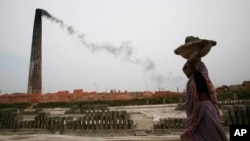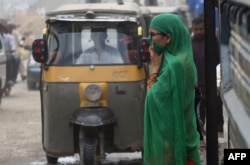A new environmental report says rising air pollution across South Asia can cut life expectancy rates by up to five years.
South Asia includes the world’s most polluted countries, including India, Bangladesh, Nepal and Pakistan. The area accounts for more than half of the total lives lost worldwide to pollution, the Energy Policy Institute said in its latest Air Quality Life Index. The institute is part of the University of Chicago.
The report blames the air pollution dangers on fast industrialization and population growth across South Asia. Researchers estimate the area currently has particle pollution rates that are 50 percent higher than at the start of the century.
Individuals living in Bangladesh, the world's most polluted country, stand to lose 6.8 years of life on average per person, the report found. This compares to 3.6 months in the United States. The information is based on satellite data used to estimate the effects of increased airborne fine particles on life expectancy.
The report said India has been responsible for about 59 percent of the world's increase in pollution since 2013. In densely populated New Delhi, the world's most polluted large city, the average life expectancy had dropped by more than 10 years.
The report called for cuts in worldwide levels of lung-harming airborne particles to levels sought by the World Health Organization (WHO). If these cuts were reached, it could raise average life expectancy rates by 2.3 years.
A person living in Pakistan would gain 3.9 years from meeting WHO pollution guidelines, the report added. And in Nepal, a person would live 4.6 years longer if the guidelines were met.
The report noted that China has worked to reduce pollution by 42.3 percent between 2013 and 2021. The researchers said this shows the need for governments to produce and share air quality data to help reduce inequalities in getting tools to fight pollution.
I’m Bryan Lynn.
Reuters reported on this story. Bryan Lynn adapted the report for Learning English.
_____________________________________________________
What do you think of this story? We want to hear from you. We have a new comment system. Here is how it works:
- Write your comment in the box.
- Under the box, you can see four images for social media accounts. They are for Disqus, Facebook, Twitter and Google.
- Click on one image and a box appears. Enter the login for your social media account. Or you may create one on the Disqus system. It is the blue circle with “D” on it. It is free.
Each time you return to comment on the Learning English site, you can use your account and see your comments and replies to them. Our comment policy is here











Forum